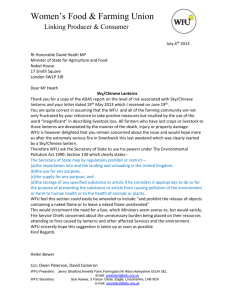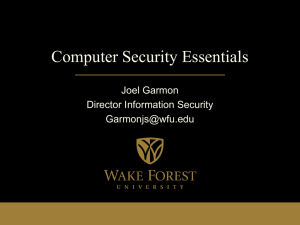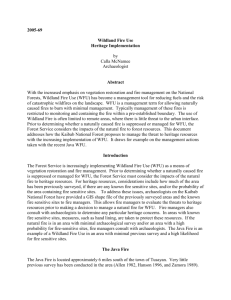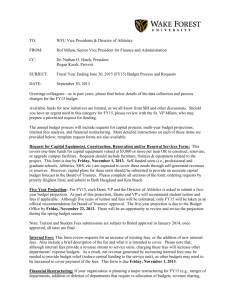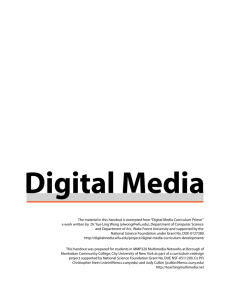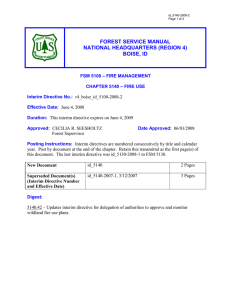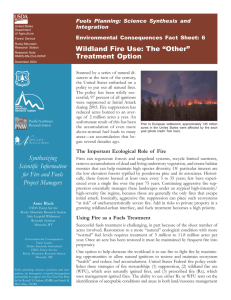Factors in United States Forest Service district rangers’
advertisement
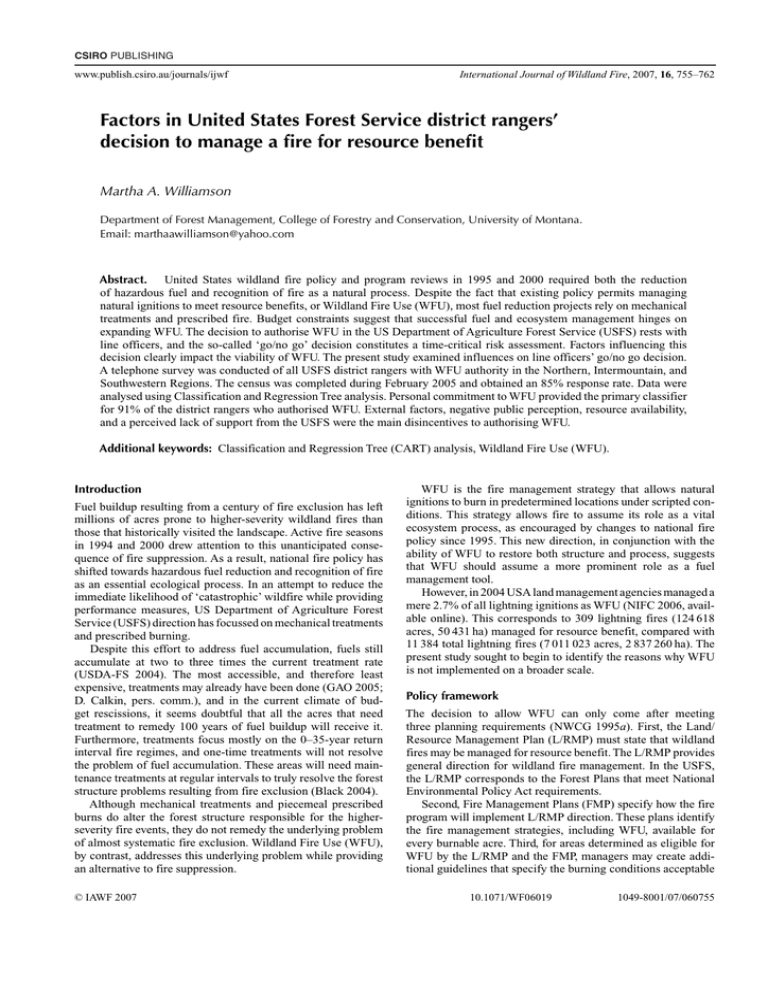
CSIRO PUBLISHING www.publish.csiro.au/journals/ijwf International Journal of Wildland Fire, 2007, 16, 755–762 Factors in United States Forest Service district rangers’ decision to manage a fire for resource benefit Martha A. Williamson Department of Forest Management, College of Forestry and Conservation, University of Montana. Email: marthaawilliamson@yahoo.com Abstract. United States wildland fire policy and program reviews in 1995 and 2000 required both the reduction of hazardous fuel and recognition of fire as a natural process. Despite the fact that existing policy permits managing natural ignitions to meet resource benefits, or Wildland Fire Use (WFU), most fuel reduction projects rely on mechanical treatments and prescribed fire. Budget constraints suggest that successful fuel and ecosystem management hinges on expanding WFU. The decision to authorise WFU in the US Department of Agriculture Forest Service (USFS) rests with line officers, and the so-called ‘go/no go’ decision constitutes a time-critical risk assessment. Factors influencing this decision clearly impact the viability of WFU. The present study examined influences on line officers’ go/no go decision. A telephone survey was conducted of all USFS district rangers with WFU authority in the Northern, Intermountain, and Southwestern Regions. The census was completed during February 2005 and obtained an 85% response rate. Data were analysed using Classification and Regression Tree analysis. Personal commitment to WFU provided the primary classifier for 91% of the district rangers who authorised WFU. External factors, negative public perception, resource availability, and a perceived lack of support from the USFS were the main disincentives to authorising WFU. Additional keywords: Classification and Regression Tree (CART) analysis, Wildland Fire Use (WFU). Introduction Fuel buildup resulting from a century of fire exclusion has left millions of acres prone to higher-severity wildland fires than those that historically visited the landscape. Active fire seasons in 1994 and 2000 drew attention to this unanticipated consequence of fire suppression. As a result, national fire policy has shifted towards hazardous fuel reduction and recognition of fire as an essential ecological process. In an attempt to reduce the immediate likelihood of ‘catastrophic’ wildfire while providing performance measures, US Department of Agriculture Forest Service (USFS) direction has focussed on mechanical treatments and prescribed burning. Despite this effort to address fuel accumulation, fuels still accumulate at two to three times the current treatment rate (USDA-FS 2004). The most accessible, and therefore least expensive, treatments may already have been done (GAO 2005; D. Calkin, pers. comm.), and in the current climate of budget rescissions, it seems doubtful that all the acres that need treatment to remedy 100 years of fuel buildup will receive it. Furthermore, treatments focus mostly on the 0–35-year return interval fire regimes, and one-time treatments will not resolve the problem of fuel accumulation. These areas will need maintenance treatments at regular intervals to truly resolve the forest structure problems resulting from fire exclusion (Black 2004). Although mechanical treatments and piecemeal prescribed burns do alter the forest structure responsible for the higherseverity fire events, they do not remedy the underlying problem of almost systematic fire exclusion. Wildland Fire Use (WFU), by contrast, addresses this underlying problem while providing an alternative to fire suppression. © IAWF 2007 WFU is the fire management strategy that allows natural ignitions to burn in predetermined locations under scripted conditions. This strategy allows fire to assume its role as a vital ecosystem process, as encouraged by changes to national fire policy since 1995. This new direction, in conjunction with the ability of WFU to restore both structure and process, suggests that WFU should assume a more prominent role as a fuel management tool. However, in 2004 USA land management agencies managed a mere 2.7% of all lightning ignitions as WFU (NIFC 2006, available online). This corresponds to 309 lightning fires (124 618 acres, 50 431 ha) managed for resource benefit, compared with 11 384 total lightning fires (7 011 023 acres, 2 837 260 ha). The present study sought to begin to identify the reasons why WFU is not implemented on a broader scale. Policy framework The decision to allow WFU can only come after meeting three planning requirements (NWCG 1995a). First, the Land/ Resource Management Plan (L/RMP) must state that wildland fires may be managed for resource benefit. The L/RMP provides general direction for wildland fire management. In the USFS, the L/RMP corresponds to the Forest Plans that meet National Environmental Policy Act requirements. Second, Fire Management Plans (FMP) specify how the fire program will implement L/RMP direction. These plans identify the fire management strategies, including WFU, available for every burnable acre. Third, for areas determined as eligible for WFU by the L/RMP and the FMP, managers may create additional guidelines that specify the burning conditions acceptable 10.1071/WF06019 1049-8001/07/060755 756 Int. J. Wildland Fire for WFU (USDA/USDI 2003). A WFU ‘guidebook’ typically houses these guidelines. In short, the L/RMP must state that WFU is a potential fire management strategy. The FMP must state where WFU is a potential fire management strategy. The WFU Guidebook may state under what conditions WFU is a potential fire management strategy. These planning stages must be completed before any ignition is considered a candidate for WFU. Finally, for a candidate lightning strike, the Wildland Fire Implementation Plan Stage 1 (WFIP1) must be carried out to further validate the acceptability of the ignition. This time-critical process, which must be completed within 8 h of detection1 , first evaluates the candidate fire’s physical elements against the criteria established in the FMP and in the WFU guidelines. The WFIP1 then guides managers through a five-element ‘Decision Criteria Checklist’: • Is there a threat to life, property, or public and firefighter safety that cannot be mitigated? • Are there potential effects on cultural and natural resources outside the range of desired effects? • Are relative risk indicators and risk assessment results unacceptable to the appropriate line officer? • Is there other proximate fire activity that limits or precludes successful management of the fire? • Are there other line officer issues that preclude WFU? A ‘yes’ answer to any one element leads to a decision to suppress the fire. Federal fire policy and Agency policy further limit the line officer’s freedom to make decisions. Foremost, public and firefighter safety take precedence over any other concern (USDA-FS 2000), and only trained and qualified personnel may implement a WFU project (USDA-FS 2000). Furthermore, only natural ignitions may be managed for resource benefits (USDA/USDI 2005). In addition, each wildland fire may have only one objective, and suppression overrides resource benefit in case two fires merge (USDA/USDI 2005). The decision to authorise WFU ultimately rests with line officers (USDA/USDI 2005). The need for managerial accountability has created a decision process that places all of the authority (and consequent liability) on these administrators. Specifically in the USFS, District Rangers are the line officers most frequently required to make the go/no go decision on whether to allow WFU. All federal land management agencies must follow national policy direction that mandates allowing fire to function in its natural role (NWCG 1995a). Assessing the feasibility of this policy and facilitating WFU implementation demands understanding the drivers of the go/no go decision. Drivers of the go/no go decision Although no formal studies have identified the considerations playing into the go/no go decision, several authors have touched on factors potentially affecting this decision. The potential considerations either discourage or bolster a go decision. 1 M. A. Williamson The principal factors acting against authorising WFU include risk, liability, lack of public support, air quality, and inadequate staffing. Most frequently, authors cited the risk of a WFU event escaping as a barrier to authorising WFU (Arno and Brown 1991; Daniels 1991). This risk assumes greater importance when calculated with potential damage to private property, natural resources, and professional consequences (Czech 1996; Miller and Landres 2004; Arno and Fiedler 2005). Negligence could indicate liability for ensuing damages (White 1991), further raising the stakes. In the case of employee injury, decision-makers could be held liable without evidence of negligence (Stanton 1995). Lack of public support (Daniels 1991), coupled with the documented need for public buy-in for successful fire and fuels management (Cortner et al. 1990; Shindler and Toman 2003; Weible et al. 2005) could also influence the line officer’s decision. Further, air quality concerns from both regulatory and public opinion perspectives could also weigh in (NWCG 1995b; Cleaves et al. 2000). Staffing concerns affect the decision to authorise WFU in two ways. The manager’s ability to commit resources and attention to managing a WFU event for an extended and indeterminate period enters into the go/no go decision (Daniels 1991;Tomascak 1991; Bonney 1998). Sufficient availability of highly qualified personnel also weighs heavily in the decision to use WFU (Cortner et al. 1990; Daniels 1991; Cleaves et al. 2000; Miller and Landres 2004). Although lack of availability of qualified staff could lead to a no-go decision, the opposite could help trigger a go decision. Although these authors predominantly suggest factors that tip the decision towards no go, others indicate influences in favour of authorising WFU. Anecdotal evidence of cost savings through WFU suggests this as a possible motivator (Daniels 1991; Czech 1996; Bonney 1998; Calkin et al. 2005). In addition to reducing costs, the desire to minimise firefighter exposure to the dangers of wildland fires could also influence the go/no go decision (Bonney 1998). Finally, a dedication to stewardship that dictates a commitment to restoring fire could inspire a go decision (Pyne 1995; Miller and Landres 2004; Arno and Fiedler 2005). Although the line officer ultimately makes the decision to authorise WFU, no study has sought their input as to the relative importance, if any, of the elements found in the literature described above. Understanding the drivers of the go decision requires identifying the factors affecting the people who must assume responsibility for the consequences. The goal of the present study was to determine the factors influencing the line officers’ go/no decision on WFU. Methods The current study’s goal narrowed the potential population to those line officers able to authorise WFU in their areas. As an Agency with a mandate to manage for multiple use, the USFS presented an ideal candidate for examining the complex decision-making behind WFU. Meteorological factors and confidentiality concerns indicated that USFS district rangers with WFU authority on their districts in the USFS Northern, Until January of 2005, including the fire season preceding the present study, line officers operated under a 2-h time constraint. Influences on decision to authorise Wildland Fire Use PROTOCOL (Policy) Int. J. Wildland Fire PUBLIC SUPPORT (Literature) EXTERNAL FACTORS INFLUENCING RISK (Literature) STAFFING/ AVAILABILITY (Literature, policy discussions) 757 LIABILITY (Literature) AGENCY SUPPORT (Discussions) Go or no go? STEWARDSHIP (Literature, discussions) AIR QUALITY (Literature, policy) BUDGET (Literature, discussions) STAFFING/ TRUST (Discussions) COMFORT WITH FIRE (Discussions) SAFETY (Literature, discussions) Fig. 1. Possible factors influencing go/no go decision. Southwestern, and Intermountain Regions (1, 3, and 4, respectively) provided an appropriate population to investigate. These regions represent a swath through the Intermountain west, and include forests with WFU authority in Montana, Idaho, Nevada, Wyoming, Utah, Arizona, and New Mexico. The present study did not include district rangers in the USFS Rocky Mountain (Colorado, Wyoming, South Dakota, Kansas, Nebraska) and Pacific Northwestern Regions (Oregon and Washington) because too few rangers in these regions have WFU authority on their districts to guarantee confidentiality in their responses. The USFS employee directory, available on the internet, provided names, email addresses, and phone numbers of district rangers. Unpublished data provided by the USFS Rocky Mountain Research Station Aldo Leopold Wilderness Research Institute identified forests with WFU approved in their forest plans. This identification process led to a potential population of 81 district rangers with WFU authority both in and out of designated wilderness across Regions 1, 3, and 4. Twenty-nine rangers with WFU authority work in the Northern Region (Region 1), 27 in the Southwestern Region (Region 3), and 25 in the Intermountain Region (Region 4). Given the small population size, the current study conducted a census rather than a sample of the identified district rangers. The present study relied on a telephone questionnaire rather than a mailed one owing to the associated improvements in response rate and efficiency (Dillman 1978; Groves et al. 2004). Questionnaire construction followed widely accepted guidelines (Sudman and Bradburn 1982; Groves et al. 2004), and included a pilot test that targeted a subset of line officers (not surveyed as part of the main study). No previous studies made the use of an a priori model possible. Instead, the policy framework and the potential drivers of the go/no go decision, discussed previously in the present paper, provided a basic model for developing appropriate questions to include in the survey instrument. In addition, discussions with land managers experienced with WFU yielded additional factors to consider. Question formulation followed guidelines outlined by Groves et al. (2004). The questionnaire included 50 multiple-choice questions and six open-ended ones. The multiple-choice questions assessed the degree to which the factors identified in the literature and pilot test contributed to the go/no go decision. The open-ended questions asked the respondents to volunteer their perceptions on what factors influenced their decision – which could reveal factors not identified during question development. Respondents were invited to expand on their answers, although these discussions were not included in the statistical analysis. Fig. 1 illustrates the factors possibly influencing the go/no go decision, as identified in the policy framework, the literature review and discussions with the land managers experienced with WFU. These sources of the factors are included in parentheses. Questions were developed to investigate the factors illustrated in Fig. 1.These 12 factors were then grouped into eight categories based on the author’s judgement. In turn, these eight categories became the evaluation framework and the independent variables used in analysis. Table 1 summarises the eight categories, the factors included in the category, an example of a question, and the related variable. Interviews were conducted between 9 February 2005 and 21 March 2005. Classification and RegressionTree (CART) analysis was used to examine this dataset. This analysis technique was chosen because it would allow any given line officer to be identified as a ‘goer’ or a ‘no-goer’ based on their answers to the questionnaire. Much like logistic regression, CART analysis determines what mix of factors will best predict a given outcome. However, unlike logistic regression, which yields probabilities, CART analysis simultaneously selects the independent variables and determines 758 Int. J. Wildland Fire M. A. Williamson Table 1. Questions and related evaluation framework Perceived Agency support (AGSPRT), perceived program value (PROGVAL), external factors (EXT), concern for public perception (PUBPERC), experience with fire (FIRE), confidence in staff (STFTRST), staffing level (STAFFLVL) and protocol (PROTOCOL) Category Additional factors included Example question Variable name Agency support Liability, budget To what extent, if at all, does concern over negative impacts on your career influence your go/no go decision? AGSPRT To what extent, if at all, do you think that Wildland Fire Use is an effective tool for returning fire to the landscape? PROGVAL To what extent, if at all, does time of year influence your go/no go decision? EXT Concern for public perception To what extent, if at all, does concern for public support affect your go/no go decision? PUBPERC Stewardship External factors influencing risk Safety, air quality Fire experience and comfort with fire Were you the line officer for any Type 1 or 2 suppression fires? FIRE Trust in staff How often, if ever, do you feel that you and your Fire Management Officer share similar attitudes about what constitutes an appropriate go/no go decision? STFTRST Resource availability To what extent, if at all, do you feel that you have access to the resources you need to manage a fire as Wildland Fire Use? STAFFLVL Policy To what extent, if at all, do you think that your Fire Management Plan contains useable information for the go/no go decision? PROTOCOL the breakpoints in these variables that characterise the dependent variable. CART analysis results in a tree diagram: each independent variable and its associated breakpoint are identified in a decision node. For example, to identify a fruit as an apple or a lemon based on colour, CART could determine one breakpoint at the colour yellow. All fruits meeting the rule ‘colour equals yellow’ would move to the left: this would isolate the lemons. Cases that meet the breakpoint rule move down the tree to the left, whereas cases that fail the rule move down the tree to the right. Cases continue moving down the tree until there are no more decision nodes and the case comes to rest in a terminal node. CART grows the tree until adding additional decision nodes would overfit the model. The CART model used a binary target variable, WFU. The binary variable resulted from collapsing the responses to the first survey question asked: ‘Thinking about the last three fire seasons, since 2002, about how many lightning starts in the WFU-approved area have you managed as WFU?’ A score of 0 was attributed to answers of ‘none’ or ‘few’. ‘About half ’, ‘most’ or ‘all’ were attributed a score of 1. Model runs used Salford Systems CART 5.0 software (Steinberg and Colla 1997) and kept the default settings of the Gini splitting criterion, 10-fold cross-validation, minimum parent node n = 10, and minimum child node n = 1. The best tree was selected based on minimum probability of misclassification estimated through cross-validation. Cross-validation (test) prediction success provides the most accurate estimate of model performance (Steinberg and Colla 1997). The model used the independent variables summarised in Table 1 to classify the district rangers as having authorised WFU on their unit. These variables, which reflect the question groups explored in the questionnaire, are confidence in staff (STFTRST), external factors (EXT), experience with fire (FIRE), perceived Agency support (AGSPRT), protocol (PROTOCOL), perceived program value (PROGVAL), staffing level (STAFFLVL) and concern for public perception (PUBPERC). For all variables, larger values indicate higher levels of the variable in question; for example, a value of two for confidence in staff indicates higher confidence in staff than a value of one. Results Contact with 22 district rangers revealed that they did not have WFU authority on their districts and reduced the actual population to 59 from 81. Twenty-one (of 25) district rangers from Region 1, 12 (of 16) from Region 3, and 17 (of 18) from Region 4 participated. The most conservative computation (AAPOR 2004) yields a response rate of 84.75%. Conducting a census eliminates concerns of sampling errors. Furthermore, as a census with an 84.75% response rate, errors of non-observation cause minimal concern. Although not eradicated, errors associated with coverage and non-response were minimised. Of nine non-respondents, four corresponded to either vacant positions or positions that had been filled since the 2004 fire season. The remaining five non-respondents face contexts (terrain, weather, fuel, and political) similar to their neighbours who participated. This similarity in geographical and political situations suggests that their responses would resemble their neighbours’ and would therefore not alter the study’s results. A combination of residual instrument errors and respondent errors may have been the most significant source of error in the data collected. Several of the questions either reflected areas of Agency direction or inquired after professional motivations. Influences on decision to authorise Wildland Fire Use Int. J. Wildland Fire 759 PROGVAL ⱕ3.8 (program value) Go: 22 No go: 28 PUBPERC ⱕⴚ0.2 (concern for public perception) Go: 21 No go: 18 Go: 1 No go: 10 Terminal node 1 Go: 0 No go: 4 STFTRST ⱕ2.4 (trust in staff ) Go: 21 No go: 14 Terminal node 6 EXT ⱕ6.5 (external factors) Go: 20 No go: 9 Go: 1 No go: 5 Terminal node 2 AGSPRT ⱕ2.5 (Agency support ) Go: 20 No go: 7 Go: 0 No go: 2 Terminal node 5 Go: 20 No go: 5 Go: 0 No go: 2 Terminal node 3 Terminal node 4 Fig. 2. Classification and Regression Tree (CART) analysis Model 1. Table 2. Model 1 test prediction success Decision No go Go Actual class Predicted class Percentage predicted correctly 28 22 19 14 67.9 63.6 Despite confidentiality guarantees, the respondents could have opted to ‘toe the Agency line’ and not provide completely candid answers. Analysis Model 1 from the CART analysis used eight variables to classify the dependent variable. This classification resulted in a tree with five decision nodes and six terminal nodes (Fig. 2). Program value, concern for public perception, staff trust, external factors, and Agency support successfully identified 63.6% of respondents who authorised WFU. Table 2 summarises Model 1 performance. Fig. 2 depicts Model 1. Each intersection, or node, provides a make-or-break rule for whether or not the respondent will continue down the tree. Respondents whose answers meet the splitting rule move down the path to the left. The tree shunts respondents who fail the splitting rule to the right. The first intersection, at program value (PROGVAL ≤3.8), diverts 11 respondents and classifies them as not authorising WFU (terminal node 1). This indicates that program value is the most important factor, and progression to the next decision rules hinges first and foremost on the score for this variable. Respondents who make it through the intersection at program value move to the next one, at concern for public perception (PUBPERC ≤−0.2). Here, though counter-intuitive, respondents who reported less concern for public support are classified as not authorising WFU (terminal node 6). Survey participants who reported higher concern for public support (lower negative score) continue to the next intersection, which occurs at staff trust. This more intuitive split (STFTRST ≤2.4) indicates that staff trust plays the next most important role in determining whether or not respondents have authorised WFU. Respondents who reported a level of confidence in their staff below 2.4 are 760 Int. J. Wildland Fire classified as not authorising WFU (terminal node 2) and do not continue down the tree. The next criterion involves external factors. Respondents who scored at the upper end of external considerations (EXT >6.5) do not authorise WFU (terminal node 5). Those who meet the splitting rule of EXT ≤6.5 move on to the final intersection, at Agency support. This final tier separates those respondents who perceive that the Agency facilitates the decision to use WFU. Again counter-intuitively, respondents who scored above the threshold value of 2.5 did not authorise WFU (terminal node 4). Conversely, respondents who met the decision rule AGSPRT ≤2.5 did authorise WFU (terminal node 3). Ninety-one percent (20 of 22) of respondents who authorised WFU follow the tree all the way through to the final intersection at Agency support. Discussion Interpretation of CART analysis results indicates that the go/no go decision rests on personal commitment to returning fire to the landscape. This overarching theme helps explain the somewhat counter-intuitive modelling results. The decision structure presented by Model 1 highlights potential deterrents to WFU, and responses to individual survey questions expand on them. The CART model suggests that the value placed on the WFU program provides the most important determinant of whether a respondent authorised WFU. As one respondent in Region 1 said, ‘You are acting outside the scope of your employment if you do not do what is best for the land’. From Model 1 emerges a group of decision-makers that stands behind returning fire to the landscape, and is strongly motivated by ‘doing the right thing’ for the land. In addition, these district rangers have confidence in their staff, report concern for public perception and do not feel supported by their employer. As one respondent said, ‘The nexus of temporal, spatial, and political factors doesn’t always align’, and yet individuals driven by their desire to do right by the land will proceed with WFU. The results of Model 1 suggest that a stewardship ethic, ‘the laudable, noble goal of ecosystem restoration’, mentioned by one respondent, motivates a cohort of district rangers who are convinced that WFU will accomplish this goal. The CART model suggests that this cohort will predictably determine that potential benefits to the resource outweigh potential risks, and decide to go. The model suggests the idealistic nature of those who reliably authorise WFU, but also highlights the obstacles that prevent district rangers from authorising WFU across the board. Responses to the open-ended questions in the present study flesh out the framework suggested by the CART model and draw attention to the risks that make implementing a stewardship ethic a costly gamble. External factors, public perception, resource availability, and Agency support all surfaced as top considerations that inhibited the go decision. As one respondent 2 M. A. Williamson mentioned, ‘To some there is more value to the resources at risk than value to allowing fire back on the landscape’. In two of the open-ended questions2 , environmental factors came up as the main consideration influencing the go/no go decision, and a key to managing non-suppression fires to meet objectives. Fire danger indices were mentioned seven times in the context of managing a non-suppression fire and 21 times as the top consideration in the go/no go decision. Location and time of year surfaced 17 and 16 times, respectively, as the most important factors influencing the go/no go decision. Beyond these repeated concerns, weather, ignitions, smoke, and threatened and endangered species habitat all came up as considerations that weighed in the go/no go decision. These factors reflect concern for ‘risk of the unknown’ that eight respondents mentioned as a disincentive to use WFU. Deciding to authorise a WFU event can engage a district’s management capacity for an extended period. The time commitment involved depends on unpredictable events such as weather and lightning ignitions. Amid this uncertainty, air quality and endangered species regulations, in addition to private property considerations, impose definite restrictions on management activity. Even for those supportive of fire restoration, the daunting requirements to ensure in this uncertain environment often prove prohibitive. Indeed, in the words of one respondent, ‘WFU is risky business’. Public support and public perception surfaced six times as a requirement for managing non-suppression fires to meet objectives and seven times as a disincentive to using WFU. Respondents evoked concerns for the potentially negative political consequences of the external considerations described above. Political sensitivity carried special weight in areas with highprofile or a very vocal public: as one respondent asserted, ‘Dick Cheney is not too hip on smoke’. Smoke, perceived or real threats to threatened and endangered species habitat, and resource damage perceived as unacceptable by the public or by others within the Agency all came up as specific areas of public concern. Resource availability surfaced 20 times as the top factor entering into the go/no go decision, 14 times as what was needed to manage a non-suppression fire to meet objectives, and in 18 of 43 unprompted discussions that arose during the interviews. Respondents mentioned that the level of qualifications required for fire use managers constrained WFU authorisation. In addition, several respondents indicated that they lacked skilled personnel in sufficient numbers to manage WFU. As several respondents mentioned, ‘We need trained people with the right qualifications’. Respondents also indicated that candidate lightning ignitions frequently occurred when other fire activity was high. In these situations, the line officers did not have the staff on hand to manage the ignitions as WFU. Potential staff shortages caused concern given the indeterminate duration of WFU events. Respondents mentioned the need for aerial resources in addition to personnel. Two respondents specifically indicated that the availability of helicopters had allowed them to manage WFU events to meet their objectives. In both cases, water-bucket drops ‘What do you think is needed to manage a non-suppression fire to meet your objectives?’ and ‘Thinking about the decision-making behind the go/no go decision on WFU as a whole, what are the top three factors that influenced your decision on every project?’ Influences on decision to authorise Wildland Fire Use by the helicopters cooled down flanks that would have otherwise hit management action-points and triggered a shift to suppression. The need for Agency support surfaced as a requirement for managing non-suppression fires to meet objectives. Respondents also cited a perceived lack of Agency support as a disincentive to authorising WFU. This perceived lack of Agency support takes two forms. First, respondents expressed a doubt that the Agency would stand behind their decision if a WFU event went awry. Potential career impacts surfaced seven times as a disincentive, and 14 times in unprompted discussions.Three respondents mentioned specific concerns about the potential for criminal charges as a result of recent after-action reviews of suppression fires that led to fatalities. Weighing resource benefits against potential damage to the decision-maker’s family makes no go more attractive. Perhaps most tellingly, one respondent stated, ‘Signing ‘go’ is a lonely feeling’. Second, respondents indicated that the current focus on meeting hazardous fuel reduction targets impeded their use of WFU. Pressure to meet targets and lack of credit for WFU came up as disincentives to using WFU and surfaced in 14 unprompted discussions. These respondents indicated that they could not credit acres restored through WFU towards fuels targets. At the same time, they suggested that prescribed burn targets conflicted with using WFU. Further, two respondents reported that they would suppress lightning fires within areas prepared for prescribed burns because the WFU fire would not count towards the prescribed fire targets. Conclusion Careers in the USFS draw people with a strong commitment to working for the good of the land. For line officers, as with other Agency personnel, satisfying a personal land stewardship ethic can, and arguably should be, a principal draw to this field of work. This stewardship ethic holds true in the context of using lightning ignitions to restore fire to the landscape. The present study suggests that authorisation of WFU by district rangers primarily stems from their personal commitment to restoring fire for the good of the land, despite multiple disincentives. If national policy mandates restoring fire as a natural process, then implementation should not rely uniquely on those willing to take risks for their personal ethic. Efforts to address the public perception, resource availability, and perceived lack ofAgency support could lower the risk of go and facilitate the decision to manage fire for resource benefit. Current US congressional scrutiny of large fire costs has incited more discussion of direction to use modified suppression strategies as cost-containment measures. Although this new direction could provide the Agency support required by some line officers and encourage WFU, this direction might face barriers to implementation similar to those encountered by WFU implementation. Acknowledgements Thank you to Carl Fiedler, John Chandler, Dave Jackson and John Baldridge for their invaluable assistance throughout this project.Thank you also toAnne Black, Jane Cottrell, Craig Goodell, Mike Johnson, Carol Miller, Deb Mucklow, Laura Ward, and George Weldon for their comments and insight. The Int. J. Wildland Fire 761 Aldo Leopold Wilderness Research Institute provided financial assistance for the publication of this paper. References AAPOR (2004) ‘Standard Definitions: Final Dispositions of Case Codes and Outcome Rates for Surveys.’ 3rd edn. (AAPOR: Lenexa, KS) Arno SF, Brown JK (1991) Overcoming the paradox in managing wildland fire. Western Wildlands 17, 40–46. Arno SF, Fiedler CE (2005) ‘Mimicking Nature’s Fire.’ (Island Press: Washington, DC) Black A (2004) Wildland fire use: the ‘other’ treatment option. USDA Forest Service, Rocky Mountain Research Station, Research Note RMRS-RN23–6-WWW. (Missoula, MT) Bonney BJ (1998) Use of alternative suppression strategies during 1994 on the Clearwater National Forest. In ‘Fire in Ecosystem Management: Shifting the Paradigm from Suppression to Prescription’. Tall Timbers Fire Ecology Conference Proceedings, No. 20. 7–10 May 1996, Boise ID. (Eds TL Pruden, LA Brennan) pp. 280–283. (Tall Timbers Research Station: Tallahassee, FL) Calkin D, Gebert K, Jones G, Neilson R (2005) Forest Service large fire area burned and suppression expenditure trends, 1970–2002. Journal of Forestry 103, 179–183. Cleaves DA, Martinez J, Haines TK (2000) Influences on prescribed burning activity and costs in the National Forest System. USDA Forest Service, Southern Research Station, General Technical Report GTR-SRS-37. (New Orleans, LA) Cortner HJ, Taylor JG, Carpenter EH, Cleaves DA (1990) Factors influencing Forest Service fire managers’ risk behavior. Forest Science 36, 531–548. Czech B (1996) Challenges to establishing and implementing sound natural fire policy. Renewable Resources Journal 14, 14–19. Daniels OL (1991) A Forest Supervisor’s perspective on the prescribed natural fire. In ‘High Intensity Fire in Wildlands: Management Challenges and Options’. Tall Timbers Fire Ecology Conference Proceedings, No. 17. 18–21 May 1989, Tallahassee FL. (Ed. SM Hermann) pp. 361–366. (Tall Timbers Research Station: Tallahassee, FL) Dillman DA (1978) ‘Mail and Telephone Surveys: the Total Design Method.’ (Wiley: New York) GAO (2005) Wildland fire management: important progress has been made, but challenges remain to completing a cohesive strategy. Government Accountability Office Report GAO-05–147. (Washington, DC) Groves RM, Fowler FJ, Jr, Couper MP, Lepkowski JM, Singer E, Tourangeau R (2004) ‘Survey Methodology.’ (Wiley: Hoboken, NJ) Miller C, Landres P (2004) Exploring information needs for wildland fire and fuels management. USDA Forest Service, Rocky Mountain Research Station, General Technical Report RMRS-GTR-127. (Fort Collins, CO) NIFC (2006) ‘Wildland Fire Statistics.’ (National Interagency Fire Center: Boise, ID) Available at http://www.nifc.gov/fire_info/fire_stats.htm [Verified 16 November 2007] NWCG (1995a) ‘1995 Federal Wildland Fire Management Policy and Program Review.’ (National Wildfire Coordinating Group, National Interagency Fire Center: Boise, ID) NWCG (1995b) Prescribed fire and fire effects working team 1995 user needs survey summary. (National Wildfire Coordinating Group: Boise, ID) Available at http://www.nwcg.gov/teams/fuwt/customer.htm [Verified 16 November 2007] Pyne SJ (1995) Vestal fires and virgin lands: a reburn. In ‘Proceedings: Symposium on Fire in Wilderness and Park Management’. 30 March–1 April 1993, Missoula, MT. (Tech. coords JK Brown, RW Mutch, CW Spoon, RH Wakimoto) pp. 15–21. (USDA Forest Service Intermountain Research Station: Ogden, UT) Shindler B, Toman E (2003) Fuel reduction strategies in forest communities: a longitudinal analysis of public support. Journal of Forestry 101, 8–14. Stanton R (1995) Managing liability exposures associated with prescribed fires. Natural Areas Journal 15, 347–352. 762 Int. J. Wildland Fire M. A. Williamson Steinberg D, Colla P (1997) ‘CART – Classification and Regression Trees.’ (Salford Systems: San Diego, CA) Sudman S, Bradburn NM (1982) ‘Asking Questions.’ (Jossey-Bass, Inc.: San Francisco, CA) Tomascak W (1991) Improving a prescribed natural fire program: the Northern Region’s approach. Fire Management Notes 52, 6–8. USDA-FS (2000) FSM-5100 – Fire management. Available at http://www.fs. fed.us/im/directives/dughtml/fsm5000.html [Verified 18 April 2005] USDA-FS (2004) ‘Forest Service Performance and Accountability Report – Fiscal Year 2003.’ (USDA Forest Service: Washington, DC) USDA/USDI (2003) ‘Interagency Strategy for the Implementation of Federal Wildland Fire Management Policy.’ National Wildfire Coordinating Group, National Interagency Fire Center. (USDA Forest Service and US Department of the Interior: Washington, DC) USDA/USDI (2005) ‘Wildland Fire Use: Implementation Procedures Reference Guide.’ National Wildfire Coordinating Group. (National Interagency Fire Center: Boise, ID) Weible C, Sabatier P, Nechodom M (2005) No sparks fly: policy participants agree on thinning trees in the Lake Tahoe Basin. Journal of Forestry 103, 5–9. White DH (1991) Legal implications associated with use and control of fire as a management practice. In ‘High Intensity Fire in Wildlands: Management Challenges and Options.’ Tall Timbers Fire Ecology Conference Proceedings, No. 17. 18–21 May 1989, Tallahassee, FL. (Ed. SM Hermann) pp. 375–384. (Tall Timbers Research Station: Tallahassee, FL) Manuscript received 15 February 2006, accepted 30 April 2007 http://www.publish.csiro.au/journals/ijwf
